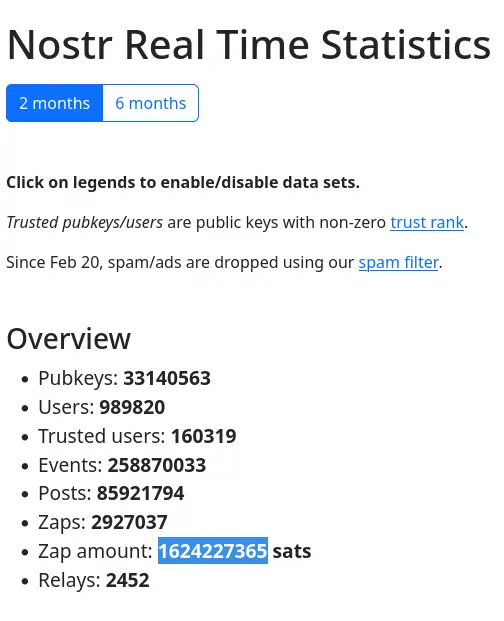Hi, my post is focusing specifically on YouTube since I observed the following categories have less intrusive solutions or privacy focused solutions, even if they are paid:
- Operating Systems (Linux, for example)
- Instant Messaging (Element, for example)
- Community Messaging (Revolt, for example)
- E-Mail (Proton, for example)
- Office (libreoffice, for example)
- Password Managers (Bitwarden, for example)
However, how do we distribute videos and watch them without data collection? I am NOT asking how do I use a privacy-focused front-end for YouTube, by the way, I am aware they exist.
I am wondering how we obtain a FOSS solution to something super critical such as YouTube. It is critical since it contains a lot of educational content (I’d wager more than any other platform), and arguably the most informative platform, despite having to filter through a lot of trash. During COVID, we even saw lecturers from universities upload their content on YouTube and telling students to watch those lectures. (I have first-hand experience with this at a respectable university).
I refuse to accept that there is nothing we can do about it.

I refuse to accept that there is nothing we can do about it.
I don’t think you quite understand just how stupendous the amount of data Google processes from YouTube alone is. There is basically no way for hobbyists to provide an equivalent service. Very few companies have those kinds of resources. If you want, you can of course try running a PeerTube instance, but you rather quickly run in to problems with scaling.
I find it almost miraculous YouTube exists to begin with. It is no accident Google has very few competitors on that front, and I don’t think YouTube is even profitable for them. Without Google’s deep pockets and interest in monopolizing the market, YouTube would have withered a long time ago.
Trust me, I want a solution too. But 500 hours of content are uploaded to YouTube every minute. All of that is processed, re-encoded, and saved with multiple bitrates. You can’t compete with that. YouTube might eventually keel over from Enshittification and its own impossibility, but replacing it with anything meaningful will be a challenge.

While I do agree with you, I also see twitch, TikTok and Patreon presenting models that are quite competitive with YouTube.
From a privacy perspective, free junk content like TikTok, YouTube and twitch will always be hard coupled with targeted advertising.
But Patreon (and onlyfans for that matter) do offer a model that can work without ads.
In fact, if Patreon also introduced an ad-supported tier and allowed you to more broadly see other content aside from the direct person you sponsor, it could probably grow quite a lot.

-
Tiktok is a company comparable in scale to Google. 130Bn in revenue last year.
-
Patreon is nowhere near the scale of YouTube. But I also think it’s the only viable solution to privacy and supporting creators.
-

I’d have agreed but hundreds of
fmoviesand similar sites exist on the high seas that provide free streaming of millions of HD content (movies, web series, etc.) somehow. They use some third-party video host that is magically able to concurrently serve millions of people.
the infrastructure of the pirate streaming sites is impressive, but I bet that is still orders of magnitude easier than hosting youtube.

Those sites just scrape from many different file hosting sites. They don’t pay for that storage themselves.

… which makes it even more wonderful, since those file hosting sites are now somehow able to serve video streaming to millions of viewers across the world FOR FREE.
Maybe the solution to YouTube is something similar to BitTorrent. It would make more sense for the protocol to preload the first chunk and to use a codec that can start with a lower res image and then fill in the resolution in subsequent passes. And on the front end, something like Lemmy would work, where channels and posts can be federated.
Considering the number of people who have 1gps symmetric bandwidth today, such a system should be able to technically work.
But nobody’s designed it yet AFAIK.

Counter-point : every single one of the videos uploaded to youtube already lives on the creators hard drive, usually in a much larger format. All that’s needed is for them to create torrents for them.

I think the largest challenge though is maintaining the distribution and managing the associated upfront costs.
Existing large content producers could likely afford to handle this but new producers could struggle paying to seed their content.
Though I do think overall this is more achievable than people give it credit for:
- YT videos don’t need huge bandwidth for a sustained period; only for short bursts. Most views come in within a week.
- Content is probably localized to specific countries. Less need to replicate across the globe.
- Let the source prefer to seed the highest quality and other peers downsample and replicate as needed.
- Doesn’t need YT scale. Tons of YT “content” is spammers leeching essentially free hosting from YT. No one needs to seed their videos if they don’t want to.
- 1080p is still fine for YT videos. h265 is very efficient (though downsampling 265 isn’t great). Don’t need 4k for most videos.

Because Google builds out their network as an ISP and doesn’t pay for the internet like the rest of us.

Peertube exists. Use it.
now I will admit that peertube is lacking content, but when you make something put it there. When you want something search there first and check out youtube last. This rewards those who publish there with your eyeballs

Are there any good PT clients for Android?

Check out newpipe

firefox works great. You don’t need an app for everything.

I think you can use web browsers with it

I like GrayJay. It has a PeerTube plugin.

Grayjay and I believe Tubular has a thing for it.

Newpipe works

Torrents solved this problem (big data distribution) over 20 years ago now, and is still a sizeable chunk of all internet media traffic.
All that’s needed is for people to actually create torrents for their content, and a user friendly way for people to post and view magnet links.
I’m trying to integrate them into lemmy in various ways: https://github.com/LemmyNet/lemmy/issues/4204

I appreciate your work. I’m thinking it should be easy to reach out to non tech content creators to get permission to migrate their stuff, and for end users like me to request that without a technical barrier. For example: I was watching a self defense channel throughout the week until the youpocalypse happened. What if there is a simple button for me to request his data to be integrated into your system? I’m pretty sure he is more focused on exposure and reach rather than ad revenue, so he might consent. You interpret this to be consent to ytdl it, store it, spread it.

Sure, a lot of people do even have entire youtube playlists and channels shared on torrents without their consent even, downloaded with youtube-dl. Getting existing content onto torrents should be pretty easy.
We do need to get these content creators to create and seed their own torrents also tho, rather than have everyone else do it on their behalf, then post their own torrent links so others can help seed.
The only clean way I see this happening is some kind of a tool that simplifies this, or a readme that can help with the process, possibly linked to lemmy’s post creation as a video/audio upload button, and on any other platform that supports magnet links.
If anyone knows of something like that already, it’d be really helpful.

I’m wondering what your thoughts on IPFS are.

I’ve never used it personally, so I don’t know.
Torrents link to static data, each with their own explicit seeders, so that always seemed more safe than these universal file-system solutions where you don’t know what might be changing, or what you’re hosting.

I only quickly looked into it. I’m also looking for a solution for my work. It seems very privacy focused and works a bit like tor, so like you say, you don’t really know what’s going through your system. But it also has a trust system that trusts friends of friends and so on, so perhaps that isn’t a problem.

I’m not sure if you can replace YouTube. It’s too popular and has been a mainstay of the Internet for 19 years. We won’t be able to convince people to just up and leave YouTube.
Best case scenario is to lead by example and start sharing videos from PeerTube.

same issue with twitter. too much momentum, not enough enshitification yet

I haven’t ever seen anything useful on twitter except funny tweets from musk

Twitter’s different IMO. It relies on the network effect, whereas YouTubers get paid.

were not talkin about the small number of creators. its all about the audience . though i see what youre sayin… chicken and egg kind of thing… its ok, google is making it hard on them

Not only that, I am certain Google will put as much money as needed into it not to allow any competing platform.
YT is not profitable, but gives them data, power and control.

Video hosting/streaming is the hardest use-case to replace due to infrastructure costs. PeerTube exists, which works like torrents and is probably the best solution that we’re gonna get for this. I don’t see it replacing YouTube though, since decentralization fundamentally limits reach (and potential income as a result) and a lack of data collection makes it harder to accurately profile viewers (both of which professional content creators care about). It’s probably fine for hobbyists and FOSS projects that want to distribute videos though.

Honestly the biggest thing all of us is missing to take it down is financial capital.
To get the kind of capital you need to take down YouTube, you need investment money from the kind of investors who will force you to enshittify to afford paying them back.
The financial issue is the biggest one, when it comes to any and all of these.

I’m not as optimistic as you.
Hosting video is really expensive. Making video is really expensive. YouTube was losing money for about 15 years despite having a monopoly on online video for most of that time and the best advertising tech in the world. I don’t think it’s possible to make a free competitor to YouTube.
On the paid side, there’s plenty of streaming services that are making money. But you have to be already established in order to get a contract. And since you will typically have to use social media in order to get past that initial barrier, it might as well include YouTube.
However, my guess is that YouTube makes the majority of it’s money from larger channels. If the larger channels all join paid streaming services(e.g. Nebula) then gradually that may be able to bring YouTube down.

The technology mostly exists. The most important question is always how do you get people to use it.
The only way I see people using decentralized solutions is by having one interface where you can watch decentralized content as well as YouTube. That way they don’t loose any of the content or convenience.
No one ever bothers to open up two apps for videos, that is why a single app solution is the only way.
The unique selling point of decentralized video plattforms atm is 1) you can watch what is banned on YouTube 2) you are not beholden to the YouTube algorithm for conent.
So if we can sell that to users and not have them loose any convenience or UX, you can slowly start replacing YouTube.
Monetization is also an important point, but others have addressed this.

What youre describing sounds alot like Grayjay

yes, you’re right. I forgot that exists. I even have it installed lmao

If they integrate some self-hosted analytics and monetization mechanics, like Matomo and Stripe, to it, then it’ll be a feasible alternative to YouTube.

Money. Lots and lots of it.
Hosting video on a significant scale is very expensive. Stupendously expensive.
Convincing people to join is also going to cost a lot of money. Consumers are on YT because creators are there, and they are already used to the platform. Creators are there because the consumers are there. And there is a robust infrastructure to make a living from content creation.
Financing is especially difficult for such a project, because companies are willing to pay way more for targeted ads. For which you need some data about your users. The more data you collect, the better the and targeting can be, the more companies are willing to pay.
Assuming there are enough users for companies to pay for advertising at all.
I was just reading this issue on Github last night and I really don’t see how PeerTube is any better than a traditional server for hosting videos. The peer part of it seems to have such a miniscule impact on the whole thing that it just feels like a gimmick. I’ve read that the biggest problem for PeerTube instance hosts is storage and not the bandwidth. The only thing that peers can save you is tiny bit of bandwidth from what I understand.
So from what I’ve gathered, relying on peers only for hosting the video is completely unviable. And that makes sense, especially for old, unpopular videos, there will be no peers to begin with. Even if every video on the site is being “seeded” by viewers, the reliability of connection and bandwidth would be very bad because you can’t know if the peer is some guy on the dial up connection. Even in the perfect scenario where everyone had very reliable connection and good bandwidth, the fact that browsers don’t support p2p protocol and rely on a hack/workaround to use it, will mean that there will be delays. So starting the video and rewinding would be painfully slow.
Is there something that I’m missing, or is PeerTube really not that much better than a “normal” video hosting server?

Peertube uses webtorrents, not regular torrents, and doesn’t even hook into the larger torrent network, which is seeding most of media on the net.
You’re correc, the peer part of peertube is mainly a gimmick at this point, and it’s nowhere close to being what torrents already are, a decentralized hosting network.

The key problem that needs to be solved is the monetization problem. Nostr has a potential solution though. Over the last two months alone, their users have “zapped” (tipped/donated) other users around 950K (nearly 1 mil!) USD worth via lightning and that number continues to grow. And it doesn’t just make it easy to pay content creators, but to also put a portion of your “zaps” towards the relay you use or development of the software if you want. If you have a nostr account, you can easily tie it to a lightning address to send/receive tips, nostr doesn’t take a fee. Relays can also portion out a bit of their zaps for the people who publish the most engaging content on their relay. The possibilities are quite extensive. And because it’s over lightning, zaps happen instantly and for pennies or less in fees. Though, you can use nostr without zaps at all.
For those unfamiliar with nostr, it’s a decentralized social media software much like ActivityPub/mastodon, the main use right now is as a twitter/instagram clone but there’s also a reddit-style section being built up as well. Video hosting itself could be done by relays or through a P2P system similar to IPFS. Moderation abilities from the perspective of the instance/relay are identical to activitypub/mastodon. But one bonus if that if your relay goes down, you don’t lose your identity, since your identity and relay are separate. And if you change apps or relays (you are typically connected to multiple relays), all your content moves with you seamlessly. And the payment/zap infrastructure is all decentralized, relays don’t ever custody or manage the payments. If you tip a content creator, it goes directly from you to them. The lightning network has basically limitless transaction capacity. If you have cash app, it supports lightning, so you can already send zaps (you will need different apps to receive zaps though because cash app doesn’t support the LNURL standard). Strike natively supports it. And because it’s lightning, it works in every country automatically.
Long-term, if I am a content creator, which “fedi”-type system is going to be attractive to me? One where users can send me tips and mircopayments or one where they can’t? This is why I think nostr is going to win out long-term over AP/Mastodon. Mastodon could add this kind of functionality but I don’t get the impression they’re open to it. People may not want to commit to yet another $5/month subscription to a YouTuber’s patreon or nebula or whatever, but they are happy to tip 1-10c after watching a video. So there’s a psychological beauty to micropayments as well. As some random person I have made like 7c on tips this month, but I’ve also given out plenty to other people.
Source about nostr fees: https://lemmy.ml/post/17824358


Unfortunately this financing requires a populace widely adopting cryptocurrency…making it a pipe dream for mainstream use.
Tips are generally a bad model as well, which creates an incentive for rapid and pandering work (like ad supported content).
Patreon had frankly built all of YouTube that is worth watching. I think a simple payment system using real banks can be integrated into smaller hosting services.
It’s all academic though, YouTube is unrivaled in ad revenue and helping you expand an audience.

25% of Americans own crypto, usage continues to grow year after year both domestically and internationally. Most people have a crypto-capable wallet on their phone (CashApp, Venmo, Paypal). It solves problems traditional financial systems can’t solve well. That’s a trend that has been happening for 15 years. You can be mad at it, but it doesn’t change that it’s true.

People want something (YouTube but not YouTube) but don’t want to learn new techniques and technology (crypto). Eventually you have to leave them behind.
I didn’t know about this Nostr, but I do believe you’re right with the content Creator coming for the money, it’s always the money.
I’m going to give it a go!

Easy solution: host an FTP with all the videos. It has existed long before YouTube was a thing.
More advanced solution: Torrent ala Pirate Bay. High quality videos have been distributed this way long before YouTube even supported 1080p. Peertube is based on similar solution as this.
The main problem is to attract content creators to the platform. The problem isn’t technical.

Dude no one can figure out ftp. Before there was yt there were embedded QuickTime videos and video podcasts

The underlying tech doesn’t matter. Only it has an easy to use interface. I just took FTP as an example of technology that already exists today.

As nice as an idea as it is, it will never be feesible for one reason: buy in. You would have to get everyone on youtube to migrate to the same platform. Just about everyone who uses windows has gripes about it, but the masses don’t migrate to Linux. Because it is change at all, and there are too many choices. I like anyone else here, would love for folks to even consider an alternative, it’s a losing battle against human nature.

Network Effect is the biggest hurdle for sure. I think it it true for so many other services too. I think we can agree there is no real technical problem to solve, we only look at the technical problems because trying to “fix” the social and political issues is a lot harder. Digital Markets Act is supposed to address this but time will tell if it has any lasting impact (in the EU).

Pray that Google enshittifies YouTube enough for any amount of creators to migrate to Peertube

I wish people would start uploading their videos to Pornhub so I wouldn’t get embarrassed whenever someone sees the app on my phone.
/s…or am I?

